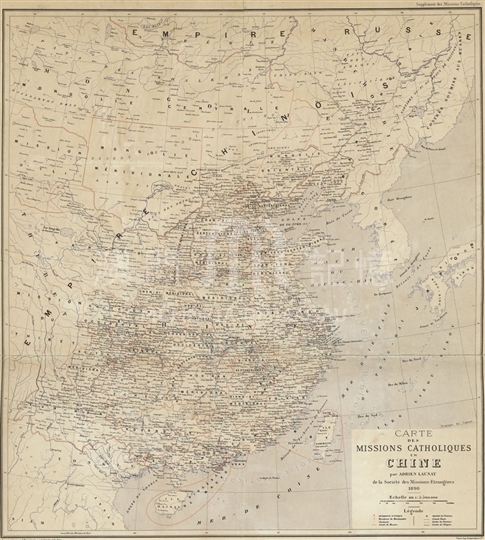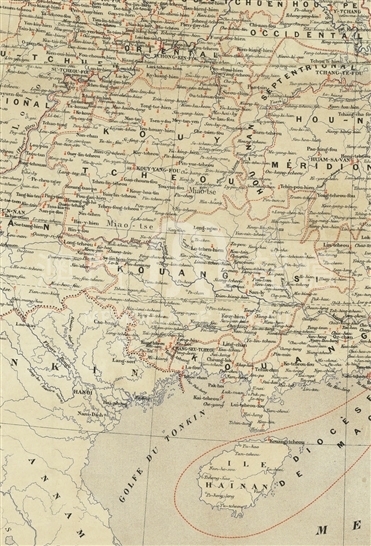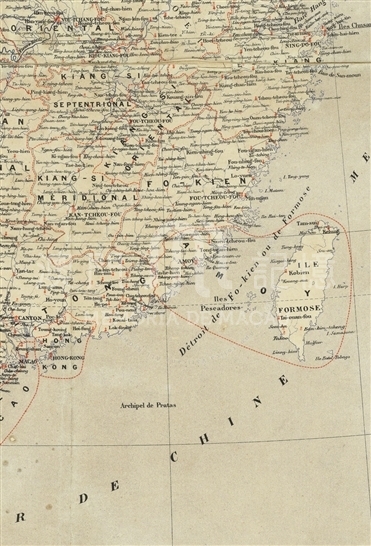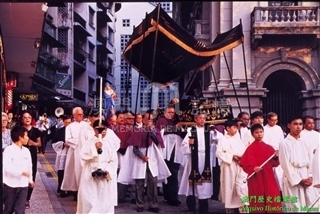This map was made by Adrien Launay, a missionary of the Society of Foreign Mission of Paris (MEP) and a chronicler. He had been to China, Southeast Asia, and once stayed in Hong Kong for being recuperated from illness. He was the author of several books about the history of MEP, including a six-volume book called Histoire des missions de Chine, and other missionary history in Vietnam, Thailand, India and other places. He also published an atlas of MEP.
This map depicts the distribution of Catholic dioceses in China in 1890. Red dotted line draw approximately 40 dioceses, with their statistics listed in the table as follows: the country's population as much as 439 million, 548,000 people as Catholics, 2,826 churches and chapels, 625 European missionaries and 342 local pastors, 948 students in 42 seminaries, 43,703 students in 2,495 Catholic schools. In the map, the Diocese of Macao has the jurisdiction over Macao, Xiangshan County, Hainan Island, Portuguese Timor and etc. Macao Diocese was established in 1576, originally in charge of missionary works from China, Korea, Japan, Vietnam and other places. Later on, more dioceses was founded followed with the spreading of evangelism, including Nanjing Diocese in 1660, Beijing Diocese in 1690, and Hong Kong Diocese in 1841. Then Portugal discussed with Roman Curia in 1874, to keep Macao Diocese in charge of Macao City, Xiangshan County, Hainan Island and Portuguese Timor. In 1908, Hainan Island was separated. After that and other following adjustments, the jurisdiction of Macao Diocese was finalized in the year of 1981.
Catholic mission was expelled from China after the well-known Rites Controversy in the late Kangxi Reign. All the following Chinese emperors banned Christianity in Chinese territory, so it was until after the Opium War that the missionaries were able to set foot in China again. In the year of 1844, China and France signed the 'Treaty of Whampoa', Catholicism came with the western trade mission and warships. Although the number of Catholic people increased rapidly under the protection of French Patronage, religious conflicts increased and intensified, along with the accumulation of a potential crisis. These situations continued and were not improved until the early twentieth century, when Father Frédéric-Vincent Lebbe and Cardinal Celso Benigno Luigi Costantini, the first Apostolic Delegate to China, began to actively cultivate and promote the Chinese people as senior clergy of Church, and to encourage the patriotism among the laypersons of Chinese Church, on the basis of mutual understanding and respect.
Reference:
[1]. Launay, A. (1903). Histoire des missions de Chine. Paris: P. Téqui.
[2]. Cheney, D. M. (2013). Diocese of Macao. The Hierarchy of the Catholic Church: Current and historical information about its bishops and dioceses. Retrieved on Feb. 14th, 2016 from http://www.catholic-hierarchy.org/diocese/dmacu.html
[3]. 顧衛民. (1996). 基督教與近代中國社會. 上海:上海人民出版社.
Informações relevantes
Data de atualização: 2020/09/08












Comentários
Comentários (0 participação(ões), 0 comentário(s)): agradecemos que partilhasse os seus materiais e histórias (dentro de 150 palavras).